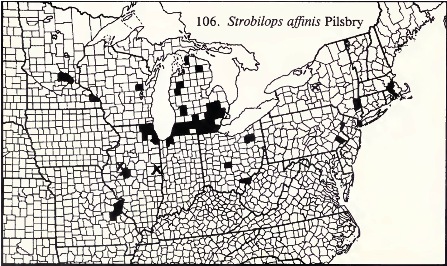Habitat
"There is no place like home!"
Strobilops affinis lives in an exclusively terrestrial
habitat. Typically the location of S. affinis is determined by
weather conditions of the area it lives in. In wet conditions
S. affinis can be found on top of logs, moving around
the surface of the log. In dry conditions S. affinis
will be found in a damp, well drained, environment such as dead leaves,
bark, and twigs on the ground (Hubricht, 1985). This snail also prefers a
habitat rich in calcium carbonate and lime, a main component of
the shell they have (Burch, 1962).
in a damp, well drained, environment such as dead leaves,
bark, and twigs on the ground (Hubricht, 1985). This snail also prefers a
habitat rich in calcium carbonate and lime, a main component of
the shell they have (Burch, 1962).
The location of S. affinis is mainly in the Eastern United States and in parts of Canada. The spread of this species in the United States is from Minnesota to Missouri and East to Pennsylvania and and New York (Hubricht, 1985). The most concentrated area where you can find S. affinis is the Southern tip of Lake Michigan (Baker, 1939). The map of the eastern United States on this page was published in 1985 and shows the geographic distribution of S. affinis at that point in time (Hubricht, 1985). The other distribution map shows the state of Wisconsin and locations known to have S. affinis. This map was published in 1999 by the State of Wisconsin Department of Natural Resources (Endangered Resources Program Species Information: Eightfold Pinecone (Strobilops affinis), 2009). A snail survey was conducted in 2003 in northeastern Wisconsin and S. affinis had 19 occurrences in the survey. Strobilops affinis was found most commonly in lowland forests with tamarack trees and lowland grasslands with mineral rich water (Nekola, 2003).
Organisms other than S. affinis also prefer damp terrestrial habitats. Among these organisms are other terrestrial snails, snakes, insects, salamanders, beetles, and plants such as ferns. Small ground rodents such as shrews and mice can also be found in the same habitat. Unfortunately these animals are also predators for land snails (Dourson, 2006). More about predators can be found on the Interactions page of this website.
